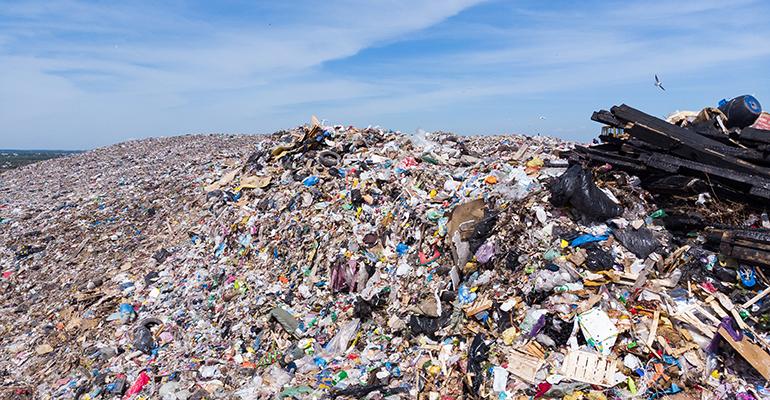Today, much of institutional and fast-casual dining — and virtually all takeout and delivery — happens using disposable foodservice ware. And all those restaurant takeout containers, bags, boxes, condiment packets, plastic utensils, cold and hot cups and lids, and napkins add up. Approximately 700 billion disposable foodservice products are used each year in the United States.
Unfortunately, all these disposables come with costs — costs to the environment from natural resource extraction to climate impacts to plastic pollution; costs to restaurants from the ongoing procurement and waste management of disposables; and costs to governments and taxpayers from solid-waste removal and litter cleanup.
These costs also represent lost opportunities to create better systems for getting consumers what they want without all the waste.
Up until now, the prevailing question for a lot of foodservice professionals has been, “Which disposable materials are best?” And of course, with all the attention being paid to single-use plastic, commercial interests are heavily promoting other single-use products like bioplastics, compostable paper products and aluminum cups as better and cleaner. At first glance, it sounds good, right?
However, at UPSTREAM we’ve examined the science behind switching from one single-use product to another, and basically it just trades one set of environmental problems for others. You might not have plastic in the environment, but now you have greater climate impacts, or more toxic chemical use, or greater natural resource extraction. And these compostable products often cost more, too.
But the good news is that reuse wins for the environment and the business’s bottom line every time. Essentially, reusables always hit a break-even point — whether it’s two uses for real cutlery to beat out plastic disposables, or 14 uses for a reusable clamshell to beat out a paper box. Once you’ve hit that break-even point, each additional use accrues more and more environmental benefits. And many reusables can be washed and used hundreds — even thousands — of times.
And what’s really exciting is there’s a new reuse economy emerging for foodservice that has the potential to completely disrupt our current disposable foodservice paradigm and replace it with something better.
Reuse for dine-in
Whether you’re dining at McDonald’s or a trendy new fast-casual eatery, disposables for dine-in are the norm. The prevailing misconception is that disposables are cheaper than reusables. The argument is that the ongoing procurement of disposable foodservice ware and the accompanying solid-waste costs still add up to less than the investment in reusables and the added labor and/or capital costs for dishwashing, not to mention concerns about product loss.
 Matt Prindiville
Matt Prindiville
But what if we told you that this argument doesn’t hold up in practice? That making the switch from single-use to reuse for dine-in always ends up saving money — 100% of the time. And that’s after accounting for any capital costs for purchasing or leasing additional dishwasher capacity and any added labor costs.
A project called ReThink Disposable in the San Francisco Bay Area worked with hundreds of foodservice operators — from cafes, fast-casual restaurants, food trucks, chains, ice cream shops, school districts, and institutional dining operations — to reduce single-use food ware and transition to reusable operations while calculating the cost and environmental impact from those changes. Restaurants saved an average net cost of $3,000 to $22,000 annually — and that takes into account all the costs required for setting up and maintaining reusable operations.
Reuse for takeout and delivery
With takeout and delivery, it might seem like the only options are between disposable paper or plastic, but scores of new businesses are emerging to offer reuse B2B (to C) services and solutions to hack all this takeout packaging waste.
Their services are easy to use, accessible, affordable, fun and convenient, and are revolutionizing how businesses do takeout by offering a circular system for collection, washing and sanitizing, and restocking reusable foodservice ware. Foodservice businesses can contract with these “reuse service providers” for the amount and types of reusable to-go ware they desire.
The reuse companies have their own systems in place for ensuring they get their products back from customers. Sometimes, it’s free to the consumer, but they have to provide their information and credit card in an app. They will get charged if they don’t return the product after a set amount of time. Other times, there are up-front deposits charged for the cups and containers, which get redeemed when they’re returned. Return locations can vary from in-store drop-off, to external kiosks around a city, to delivery drivers picking them up when consumers are finished with their meal (and/or ordering the next one).
 Samantha Sommer
Samantha Sommer
Instead of ordering fiber-based compostable clamshells at 30 cents each for your takeout and delivery needs, you could instead contract with a reuse service company to deliver the amount you need at a contracted per-unit price.
While the price point for these reuse services hasn’t yet hit below the price of disposables, it is getting close. And the more these services expand, the more likely the cost to switch will be a wash (no pun intended). More importantly, where these services are up and running, consumer surveys show a strong preference for the reusables, and it may confer stronger loyalty to participating restaurants and providers.
Lastly, some restaurants are choosing to set up and internalize their own reusable to-go service. New York City-based Just Salad, a reuse pioneer with more than 40 locations, in January launched their BringBack Bowl program at their first location in New York City. Customers ordering online can select the BringBack Bowl for pickup or delivery. The customer will receive their pickup or delivery order in a signature green Just Salad reusable bowl. The emailed order receipt will contain return instructions, and a reminder email to return the bowl is sent a few days after the order is placed.
Customers drop off their bowls at participating Just Salad locations. Twenty percent of that site’s diners opted in to the new program, and Just Salad reported a 95% return rate of checked out bowls. They are thrilled to continue and expand the program to more stores as participating customers raved about the reuse service in reviews.
In closing, part of what’s great about reuse services is that these are community-based systems. They create infrastructure and jobs in the community that cannot be outsourced. And they keep money circulating locally instead of shipping it out to where the disposable packaging gets manufactured, or where the materials to make disposables get mined from the planet — or to where all the waste gets shipped. They also keep the disposables out of local waste streams and litter off the streets — saving businesses and taxpayers money. And they create new opportunities for you to serve your customers in ways that aren’t just more sustainable, but in ways that are more enjoyable. It’s a win-win-win.
Matt Prindiville is chief operating officer of the zero-waste advocacy group UPSTREAM. He advises the United Nations Environment Program on their plastic pollution strategies and is one of the founders of the global Break Free from Plastic Movement and the founder of the Cradle2 Coalition and Make It Take It Campaign.
Samantha Sommer is director of business innovation for UPSTREAM. Previously, she directed the ReThink Disposable campaign for the national non-profits, Clean Water Action and Clean Water Fund.
This article does not necessarily reflect the opinions of the editors or management of Nation’s Restaurant News and Restaurant Hospitality.





